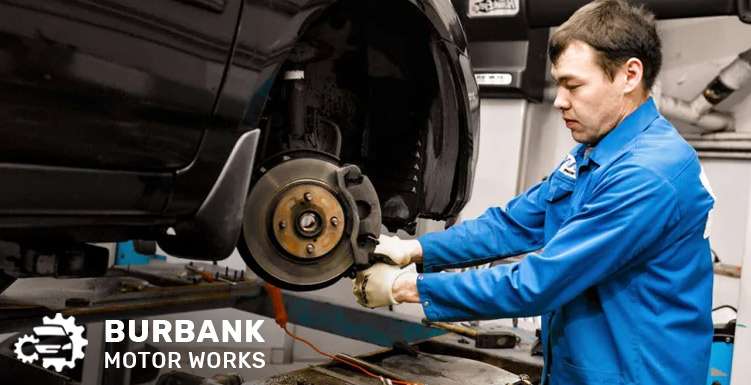
Address: 2208 W Burbank Blvd, Burbank, CA 91506

Mon - Fri: 7:45 Am - 5:30 Pm
Sat: 8:00 Am - 2:30 Pm
Sun: Closed
We'll Be Closed This Sunday – April 20th

Address: 2208 W Burbank Blvd, Burbank, CA 91506

Mon - Fri: 7:45 Am - 5:30 Pm
Sat: 8:00 Am - 2:30 Pm
Sun: Closed
Professional Burbank brake inspections will enable you to detect brake issues before they become big problems that can escalate into more costly and severe damages. Through an inspection, you will also be able to reduce the risk of accidents and collisions as an inspection can enhance the brakes’ optimal working condition.
Here at Burbank Motor Works, we understand the need for a timely and well-executed brake inspection. And that is why our Burbank brake repair team of highly skilled technicians provides comprehensive brake system inspection. We meticulously examine every aspect of your brakes, from brake pads and rotors to calipers and brake lines. Gain confidence through our brake inspection process.
Knowing when it’s time for a brake inspection is crucial to maintaining your safety on the road. If you notice any of the following signs, consider contacting your Burbank brake inspection mechanic to have a look at your vehicle:
| Squealing or Grinding Noises | If you hear unusual noises when applying the brakes, it means the brake pads have worn out and need an inspection to prevent further damage. |
| Brake Pedal Vibrations | If, when breaking, your brake pedal vibrates or pulsates, it is an indication that the brake rotor is warped and requires immediate attention and potential resurfacing. |
| Longer Stopping Distances | If your vehicle takes longer to come to a stop or if the braking feels less responsive, you may need to consult a Burbank braking expert to check what might be the problem. |
| Brake Fluid Leaks | If brake fluid leaks on the wheels or under the vehicle, the brake system has problems and needs immediate inspection. |
Your Burbank brake inspection may uncover various brake-related issues. Some common problems include:
Worn Brake Pads: Regular use of brake pads can cause them to wear out. This can then compromise their effectiveness.
Warped Brake Rotors: Brake rotors can warp due to overheating or aggressive braking. When this happens, you will notice pulsating pedals or vibrations during braking.
Stuck Brake Calipers: Sticky calipers cause uneven brake pad wear, reduced braking performance, and even overheating.
When you hire a professional brake inspection expert, you should expect a comprehensive evaluation of the entire braking system. During the inspection, the following steps will be conducted:

Visual Inspection: The technician will visually assess the brake components for wear, damage, and leaks.
Brake Pad Measurement: Brake pads will be measured to determine their thickness and evaluate their remaining life.
Rotor Inspection: Brake rotors will be checked for warping, scoring, or other signs of wear.
Brake Fluid Analysis: Brake fluid will be examined for contamination or degradation.
Brake Caliper Examination: Calipers will be inspected for proper operation and signs of sticking.
Getting a brake system inspection is very important. It allows you to detect problems before they arise. This then allows you to maintain safety and braking efficiency. If you are in Burbank and its environs and need a braking inspection, consider contacting Burbank Motor Works.
We care about your vehicle as much as you do. So you can expect top-notch inspection services from our highly trained mechanics. Reach out today at 818-848-1656, and let’s optimize your braking system.
You will need to visually inspect brake pads and rotors to check for signs such as thinning brake pads or uneven rotor surfaces. Also, evaluate if the brake calipers have any signs of sticking or if the brake lines are damaged.
Remove the brake piston brake caliper from the rotor to access the piston. Next, visually examine the piston for signs of damage, corrosion, or uneven wear. Check to see if the brake piston moves smoothly and evenly when applying pressure, as any abnormalities may indicate potential brake caliper issues that require attention.
Brake pad inspection is the process of evaluating the condition of a vehicle’s braking pad. During this process, the mechanic examines the thickness and wear of the brake pads. A brake pad inspection is essential as the pads are vital components that create the necessary friction to slow down and stop the vehicle.
The first step in checking the brake fluid is locating the reservoir. You should find the brake fluid reservoir near the master cylinder. It is a transparent or semi-transparent container with minimum and maximum level markings. Once you see the reservoir, carefully remove the cap to inspect the brake fluid level. The fluid should ideally be between the minimum and maximum marks. If it falls below the minimum level, it may indicate a possible leak or a need for brake system maintenance.
Call us for booking an early appointment and get all your car related problems solved by our experts.